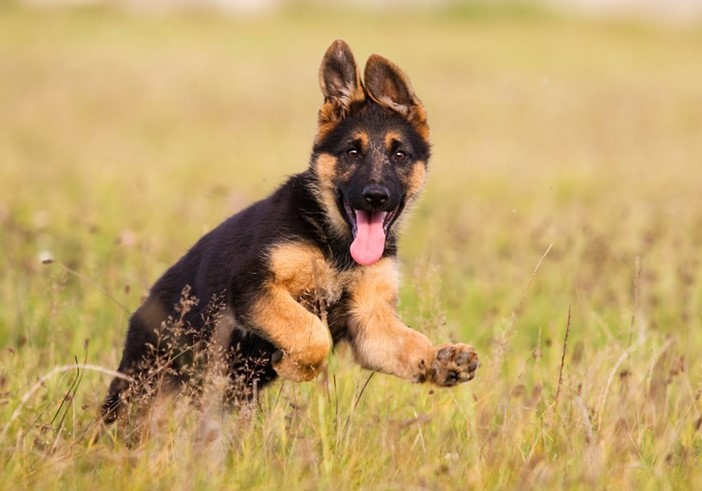Growing pains in dogs
Like in humans, growing pains also occur in dogs. Growing pains in dogs are also referred to as enostosis or enostosis and are mainly seen in fast-growing medium-sized and large dog breeds up to an age of about 18 months. Fortunately, this annoying condition eventually goes away on its own when the dog is fully grown, but of course this does not alter the fact that your four-legged friend can suffer a great deal during puppyhood. In this blog we will explain how growing pains in dogs develop, how you can recognize them, how they are treated and how you can try to prevent them.

How does growing pains occur?
Unfortunately, as much as we would like it, our dear four-legged friends do not stay small forever (depending on the breed, of course, but even smaller dog breeds grow up 😉 ) and will eventually grow into beautiful adult dogs on their own. Therefore, in growing dogs, the bones grow with them: the bones become longer and thicker, which also increases the nutritional requirements of the bone. Bones are nourished by blood, which is supplied and removed by (arterial) veins through nutritional channels running through the bone. Fast-growing dogs of medium to large breeds are more likely to experience growth spurts. Because of these growth spurts, the feeding channel in the bone cannot keep up with the growth, causing too many (arterial) veins to pass through a feeding channel that is too small. This causes veins to become compressed, which causes the draining of blood to become much more difficult. For this reason, the blood will look for another way out, causing fluid to get between the bone and the bone membrane. This causes the bone membrane to become very sensitive and may even partially detach from the bone. The pressure created on the bone membrane is incredibly painful for the dog. This is what we call growing pains.
What symptoms are associated with growing pains?
Growing pains in a young dog can be recognized by lameness. The dog may be lame on one leg, but the lameness can also involve several legs. It may even be that the dog runs lame one day on one leg and the next day on the other. Growing pains can come on suddenly and often vary in intensity. In addition to lameness, dogs may also become more sluggish and listless. If the dog is in severe pain, it may express it by squealing, whining or biting suddenly. Furthermore, fever and decreased appetite may also be symptoms of growing pains.
How do you know if your dog has growing pains?
If you suspect that your dog has growing pains, it is advisable to visit the veterinarian. Because lameness in (young) dogs can have multiple causes, the veterinarian will perform a physical examination. During such an examination, the veterinarian will put direct pressure on the periosteum. To confirm the diagnosis, an X-ray is also often taken. This is because an X-ray clearly shows the fluid accumulation between the bone and the periosteum. This allows a veterinarian to determine if it is growing pains.
How is growing pains treated?
Although growing pains eventually pass on by themselves as the dog ages, the pain is incredibly annoying for the dog. Growing pains can be treated in several ways. Painkillers and a modified exercise regimen are examples of short-term solutions. Keep in mind that painkillers do not address the cause of the growing pains, but it does help the dog live more pleasantly.
Another solution is to switch diets. Switching to foods specially formulated for young, fast-growing dog breeds helps to slow the bone growth spurt a bit. The right calcium-phosphorus ratio and extra added glucosamine and chondroitin are very important here. The latter is to support the joints.
How can you prevent growing pains?
Growing pains in young dogs can be prevented by feeding the puppy from the very beginning the right food appropriate to the age and size of the dog. Every puppy is fed puppy food until 3 months of age. Do you have a dog of a breed that has an adult weight of more than 25 pounds? Then the puppy may switch to junior large breed food starting at 3 months of age. Riverwood Junior Large Breed food is a balanced food specially formulated for young, fast-growing dog breeds. This variety contains the correct ratio of calcium-phosphorus and is also supplemented with extra glucosamine and chondroitin.
Besides the fact that Junior Large Breed has the correct ratio of calcium to phosphorus and contains extra added glucosamine and chondroitin, the ratio of fats and the size of the pellets is also different compared to "normal" puppy food. Wondering what the exact differences are between puppy food and junior large breed food? We wrote a blog about it earlier, which you can read here.
What is the prognosis for growing pains?
The prognosis of growing pains in young dogs is fortunately good, as the pains disappear once the dog is fully grown (around the age of 1.5 years). Until then, it is therefore important to feed the puppy the right food. In case of extreme pain, it can additionally be chosen to give painkillers (temporarily).
Many pets already enjoy Riverwood every day. Would you also like your dog to enjoy our delicious foods and are you curious which variety would suit your dog best? Then answer some questions about your dog here.




